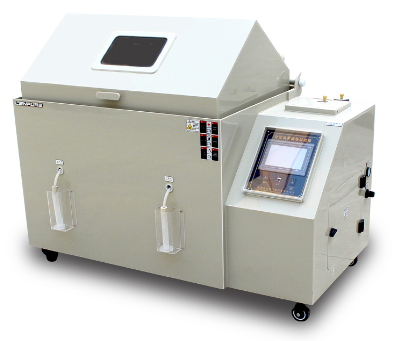Lenpure Salt Spray Test Chamber could evaluate the anti-corrosion ability of materal and material coating , make a comparsion about the product techniques and quality of similar coating and products , It be used to test the electronic elements, and metal materials and industrial products.
There is seldom a direct relation between resistance to the action of salt spray and resistance to corrosion in other media because several factors influencing the progress of corrosion, such as the formation of protective films, very greatly with the conditions encountered.

Therefore , the results obtained in the test should not be regarded as a direct guide to the corrosion resistance of the tested coatings in all environments where these coatings may be used. Also, performance of different coating in the test should not be taken as a direct guide to the relative corrosion resistance of these coating in service.
A spray cabinet, made of , or lined with, material resistant to corrosion by the sprayed solution.
The cabinet shall have a capacity of not less than 0. 2 m³ and preferably of not less than 0.4 m³ since, with smaller volumes, difficulties are experienced in ensuring even distribution of spray .
The upper parts shall be shaped that drops of sprayed solution accumulated on them do not fall on specimens beings tested.
Means for spraying the salt solution, comprising a supply of clean air of controlled pressure an humidity, a reservoir to contain the solution to be sprayed and one or more atomizers made of material resistant to the solution.
The compressed air supply to the atomizers shall be passed through a filter to remove all traces of oil or solid matter and shall be st a pressure of 70 to 170 KPA.
The atomizers shall be made of inert material, for example, glass or plastics material. Baffles may be used to prevent direct impingement of spray on the test specimens and the use of adjustable baffles is helpful in obtaining uniform distribution of spray throughout the cabinet.
At least two suitable collecting devices, which shall be funnels of glass or other chemically inert material with the stems into graduated cylinders or other containers.
The temperature inside the spray cabinet shall be 35 ℃ ±2 ℃ with the minimum possible fluctuation throughout the cabinet during the test.
The average rate of collection of solution in each device measured over a minimum period of 24h shall be 1 to 2 ml/h for horizontal collecting area of 80 cm2.
Recommended periods of exposure are 2h-6h-24h-48h-96h-240h-480h-720h.
Spraying shall not be interrupted during the prescribed test period. The cabinet shall be opened only for brief visual inspections of the test specimens in position and for replenishing the salt solution on the reservoir if such replenishment can’t be carried out from outside the cabinet.
At the end of the test period, remove the specimens from the cabinet. Allow the specimens to dry for 0.5 to 1h before rinsing, in order to reduce the risk of removing corrosion products.
Before they are examined, carefully remove residues of the spray solution from their
Surfaces.
A suitable method is to rinse or dip the specimens gently in clean running water at a temperature not exceeding 40 ℃ and then to dry them immediately in a stream of compressed air at a pressure not exceeding 200 kpa, at a distance of approximately 300 mm.
Here are some advance on how to choose a suitable salt spray chamber to do the test.
| Model | Volume (L) |
Temperature Range (°C) |
Rated Power | Internal Dimension (mm) D*W*H | External Dimension (mm) D*W*H |
| LRHS-108-RJY | 108 | RT+5°C ~ 55°C | 1.5kW | 450*600*450 | 780*1140*1050 |
| LRHS-270-RJY | 270 | 1.8kW | 600*900*500 | 960*1460*1150 | |
| LRHS-412-RJY | 412 | 4.0kW | 750*1100*500 | 1100*1730*1240 | |
| LRHS-663-RJY | 663 | 5.0kW | 850*1300*600 | 1230*2150*1410 | |
| LRHS-816-RJY | 816 | 6.0kW | 850*1600*600 | 1230*2450*1460 | |
| LRHS-1080-RJY | 1080 | 6.5kW | 900*2000*600 | 1280*2850*1460 | |
| Basic Specification | |||||
| Performance | Temperature Range | RT+5°C ~ 55°C | |||
| Air Saturator | RT+10°C ~ 70°C | ||||
| Temperature Fluctuation | ±0.5°C | ||||
| Temperature Uniformity | ≤ 2.0°C | ||||
| Salt fog fall-out Rate | 1~2ml/80 cm².h(Ave in 16 hours) | ||||
| Air Pressure | 2.00±0.01(kg/cm²) | ||||
| Spray Method | Optional continuous/periodic test time: 1~9999 H、M、S (Adjustable) | ||||
| Period time | 1~99 H , M , S (Adjustable) | ||||
| Test specimen shelf | Test specimen shelf can meet the requirements of 15℃~30℃ tilt test | ||||
| Material | Chamber material | Be made of imported reinforced hard PP plates with smooth and flat surface | |||
| Saturated air cylinder | Made of imported high-quality mirror-finished stainless steel plates (SUS304) | ||||
| Pipe | Reinforced fluorosilicone rubber tube | ||||
| Casters | 4pcs, with PU covered for protection. Height adjustable and direction universal. | ||||
| Viewing Window | Multi-layer hollow toughened glass | ||||
| Control System | breaker | Schneider miniature circuit breaker | |||
| Heater | Steipped Nickel-chromium Wire Heater | ||||
| Controller |
7'' HD true color LCD touch display Have the function of Real-time monitoring, and store 600 days of historical records, is allowed to export or upload data with U disc , also can realised remoto control |
||||
| Temperature Sensor | Platinum Resistance.PT100Ω | ||||
| Standard Configuration | Round stick , V-shaped sample shelf , Glass nozzle , Funnel , Metering cylinder Flexible pipe | ||||
| Safety Protection | Power leakage protection, Low water level protection, over-load or over-current protection/Dry burning protection. | ||||
| Voltage | AC220V/380V/440V±10%, 50Hz/60Hz or as per requirement | ||||
| Ambient Enviromental for application | 5°C~+30°C ≤ 85% R.H | ||||
For more details, please feel free to contact sales@lenpure.com
Please visit www.lenpure.com











